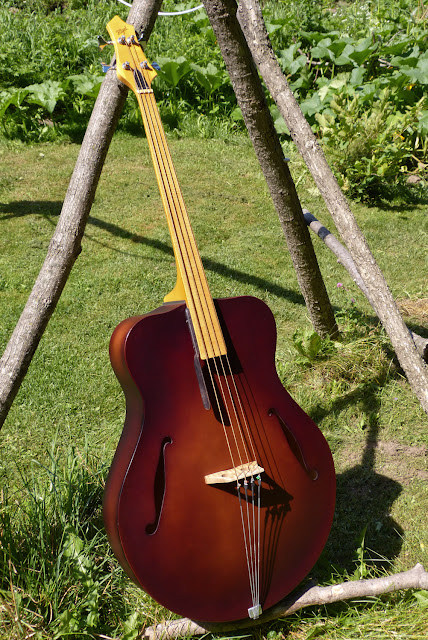2011 Rigel ABG "Acousta" Fretless Bass Guitar
This is the same Vermont-made Rigel "Acousta" that I showed, brand-new, back in 2011. It's on its 2nd owner since last year and, for a few years, now, has had a newer fretless neck installed. I like it a lot better in this format as it gets closer to an upright sort-of sound and the neck is both nice to look at and feels great. The owner of this just bought a house and is hemorrhaging cash, so he brought it in for resale despite himself.
Pete Langdell of Rigel describes the specs of the bass on his site, but to sum it up -- this is a 34 1/2" scale instrument and size-wise is around the same dimensions as a 1/4-size bass, and sonically it matches-up somewhere between a 1/4 upright and 1/2 upright. It clearly delivers a good, deep, tone and power to hang in with a small group of acoustic musicians. Pete designed these to use off-the-shelf bass guitar strings (these are phosphor bronze "acoustic bass guitar" strings), though the upright player in me really wants to see what this could do with a nice set of flatwounds. I'm thinking something like Thomastik flats would suit the afterlength on the wire tailpiece, though their price is significant compared to the strings that are on it.
I only gave this a very light setup -- adjustment at the nut -- and cleaned it up. Because it's had a few years on it, there are light scratches, dings, etc. as you'd expect for an instrument that's been gigging for 5 years straight. It still looks grand, however.
The body is all-ply and features a wedged shape -- 4 1/2" deep on the bass side and 9" deep on the treble. This provides comfort for the player and plenty of airspace. It also has a secondary soundboard (vented) just above the back on the inside and a soundpost that delivers tension to it.
The two-piece (plus headstock "wings") hard maple neck has the bonus of a flamed-maple fretboard. The truss rod is 2-way, functions well, and the neck is dead straight.
Pretty stuff, no?
The thumbrest is removable, so for players (like me) who don't use one, you can go "free and easy."
Interestingly, Pete designed the maple bridge with little pins that locate it into the top. This also keeps it secure and in place -- something very useful for a bigger instrument that can get bumped by bandmates.
It would be pretty easy to slice the bridge and convert it to an adjustable one, if desired.
The neck joint is easily adjustable up/down and the neck removes for shipping, if necessary.
Strap-locked strap buttons are placed in key areas for a good, balanced feel when standing (or sitting). This comes with a heavy-duty leather Levy's strap and I, personally, like to play it using the strap (though it's not necessary).
Don't you love that?
Here's the soundpost and a small peek at the rear, vented, secondary soundboard.
Here's a violin for comparison -- though with the fiddle in front it looks a little smaller than it truly is.























Comments